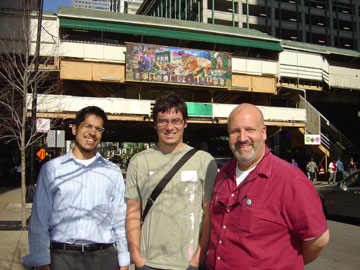My Take-Aways from Clients for Life
Once during an annual performance appraisal I was told I was a generalist, and as they supposedly could not sell me as an expert, I was not going to receive a raise or bonus. This came almost a month after I received a “client service” award from the same person. What was my reaction? I smiled, and thanked my reviewer as I considered it a compliment to be called a generalist, and then pointed out how the 1.5 year project I just completed needed a generalist. A month later I quit that company.
For some reason there is a perception being a generalist is bad. You see this more in medicine, as doctors want to be a specialist and not a general practitioner. I see this often in the IT world, as people want to be solely a programmer or designer or database administrator and only focus on those areas, and see the others as places on the other side of a thick wall. For those of us who consider ourselves generalists or those who don’t understand us, the book Clients for Life is a must read.
This book was written in 2000 so some of the company examples may no longer be in business, but the themes and messages ring true today. It takes a perspective beyond being solely a generalist and focuses on being an unselfish, independent, deep generalist advisor to your clients. Rather than offering specific advice or a service and focusing on a one-time deal with the hope of more business, the authors take the viewpoint that by being there, readily available to advice clients on a wide variety of topics and areas and being able to guide them to specific resources or services is equally rewarding and profitable. This can be summed up as the difference between a transaction and a relationship.
As this is how my career interests have come to form over the years, my primary take away was an affirmation of my goals. It also promotes the sense of long-term relationships in building a client base and as a result revenue. Anyone can tell you that the best source of business is repeat business from existing clients and referrals to others from them.
The book is a good read – at times it seems like it is repeating itself to make its point though. Some of the examples of people who were deep generalists had sometimes tragic or dramatic ends to their lives. Even if you don’t believe in this philosophy 100%, I would recommend reading it as it may help form some of your own thoughts on client development.
This is from The Hot Iron, a journal on business and technology by Mike Maddaloni.
Did you enjoy this? Subscribe to The Hot Iron by RSS/XML feed or Read by Email.
Book Take-Aways • Business • Diversions • (0) Comments • Permalink
Falling Prices and Crashing Servers
 File this under not communicating with your IT department about what is going on in the company.
File this under not communicating with your IT department about what is going on in the company.
On Monday, DVD rental service Netflix announced it was cutting its prices to better compete with Blockbuster's prices and in-store redemption service. Shortly afterwards netflix.com crashed and did not come back online until late Tuesday. It was said it was not due to the power outages in the San Francisco area, and though a specific reason was not given, it was reported the Web site was being updated to reflect the price changes.
Updating prices causes an entire network of Web servers to crash? Who wrote that software? When I worked for a publicly-traded company in the past, I was always on alert from marketing and investors’ relations whenever the company would announce earnings or have an investor’s call, as people would hit our Web site for the information or links. We had sufficient capacity with out Web servers and network, but hardware can always fail. This brings back memories of the crash of Wal-Mart’s Web site last year on “black Friday” or the busiest shopping day of the year the day after Thanksgiving.
Planning for such events and having the network, hardware and software capacity can prevent such events. Sure it may be expensive, but what price for such embarrassment?
Business • Technology • (0) Comments • PermalinkThe Zipcar of Bicycles
 PSFK recently reported on Velib, a new bike sharing program coming to Paris. The gist of the service is you pay an annual fee, roughly US$75, and you can use a special card to unlock access to a bike for 30-minutes of use, with longer periods available. The Web site is entirely in French, but if you don’t know the language you can see details of the bikes and special stations where the 451 bikes will be available. The service appears to borrow from car sharing services like Zipcar and I-GO.
PSFK recently reported on Velib, a new bike sharing program coming to Paris. The gist of the service is you pay an annual fee, roughly US$75, and you can use a special card to unlock access to a bike for 30-minutes of use, with longer periods available. The Web site is entirely in French, but if you don’t know the language you can see details of the bikes and special stations where the 451 bikes will be available. The service appears to borrow from car sharing services like Zipcar and I-GO.
This is a great idea! Though many people in cities around the world own bikes, they don’t tend to be in the best condition due to heavy usage on the mean streets, and the potential for theft. This service could allow for the casual bike rider to have access on-demand, or encourage others to use one. Not to mention it could free up a little storage space in an inner-city apartment.
Maybe Chicago could be its first US city?
Business • (3) Comments • PermalinkHappy Birthday likemind
This morning was the likemind coffee meetup in dozens of cities around the world. It marks one year of these coffee mornings, started by 2 gents who finally met for coffee themselves and decided to invite others.
This is the picture from the Chicago likemind, with Raza, Clay and myself. It was taken outside of Intelligentsia Coffee on Randolph at Wabash, and in the background is the Randolph L station.
By the way, Raza heard about likemind on WindyBits. Hope to see more people next month. And did I mention there is free coffee compliments of Anamoly?
Business • Technology • (1) Comments • PermalinkAirport Expectations and Usability
After the end of my recent trip to the Twin Cities, my lovely wife and I headed back to the Minneapolis-St. Paul Airport for our flight back to the Windy City. Being the adventurous souls we are and supporters of public transportation, we decided to take the light rail train from downtown Minneapolis to the airport. After boarding the train and checking out the uniqueness of it over other cities’ service, we saw signs that the train would not take us directly to our terminal, rather we would have to get off at the first terminal and take a bus. Little did we know that in the name of honoring local patriots, we would get lost and have a lesson in usability presented to us.
Recently the airport code-named MSP added a new terminal and named it after former US senator from Minnesota, Hubert H. Humphrey. The other and original terminal is named for aviator Charles Lindbergh. Our flight was out of Humphrey, but the light rail only stopped at Lindbergh. When we got off at Lindbergh and headed to the bus to Humphrey, the signs did not completely connect the dots and we were left wandering.
When I asked people for directions, I kept saying Lindbergh instead of Humphrey, and people would tell me that I was there already. Why the confusion? Usually airport terminals are named things like A, B and C. Sometimes letters skip, like in Atlanta, Boston and Chicago O’Hare, but they are simple letters. As L comes after H, but Lindbergh was the original terminal, this did not help. It wasn’t until I recalled the chronological order of fame by each namesake (Lindbergh before Humphrey, or at least that's how I recall learning history) I realized the new terminal was Humphrey. We finally found the signs, and made the connection in time to fly home.
To add insult to injury, the recorded announcements coming over the PA system were in a British accent. In Minnesota? Now this is not a dig on Midwesterners who are still sore over the accents in the movie Fargo, but a British accent – anywhere in the US? Sure, many international tourists come to the airport to go to the Mall of America, or connect through it, but a British accent?
Build as beautiful of a terminal as the taxpayers will allow you, put up a bronze plaque or statue to a famous person, but keep it simple for those who actually have to use it.
Business • (2) Comments • Permalink



